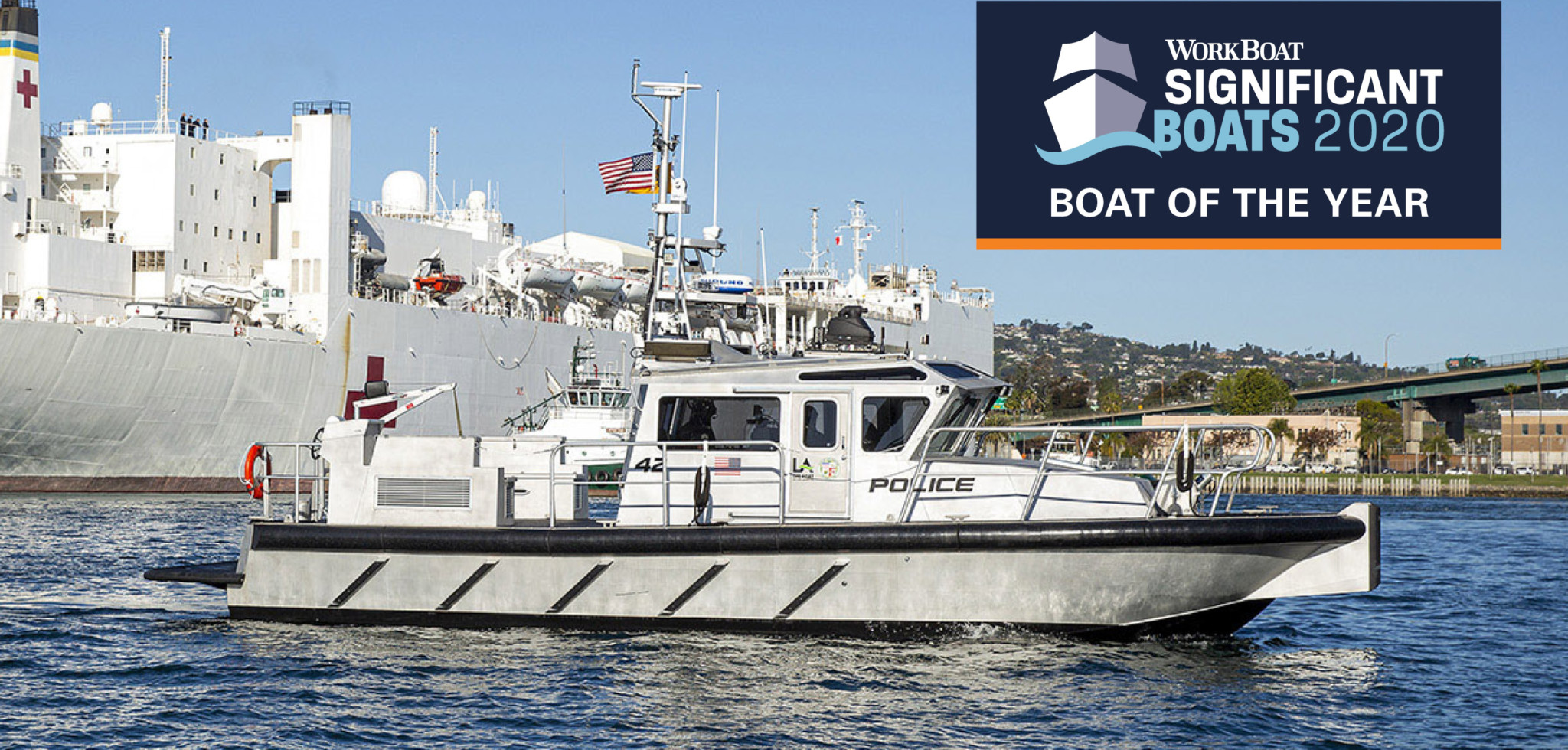WorkBoat’s Boat of the Year for 2020 is Boat 42, a 42'6"x13'4"x3'9" patrol boat for the Los Angeles Port Police. The boat patrols Los Angeles harbor. Boat 42 was built and tested at MetalCraft Marine’s two shipyards at Kingston, Ontario, Canada, and Watertown, N.Y.
Each year the editors of WorkBoat compile a list of the 10 most significant boats of the past 12 months. From that top 10 list, the readers of WorkBoat vote on workboat.com for the Boat of the Year.
The Los Angeles Port Police have been using the new patrol boat to “check every vessel that comes into the port,” said Bob Clark, MetalCraft’s, contracts manager. The vessel has a new breed of highly sophisticated, military-grade CBRN equipment aboard that can detect chemical, biological, radiological and nuclear hazards before a ship even enters the port.
The boat is fast and stable with a fine bow-entry, powerful twin Cummins 6/7L, 480-hp engines and Konrad heavy-duty duo-pro outdrives. “This means they can go offshore and check ships before they are even close to the port," Clark said. "They have discovered containers with bomb-making material. The fancy detection system is what found it. They also check the stack of every ship for pollution.”
Boat 42 is not designed to chase bad actors who have entered the port, although it can certainly do that, but to keep them from entering the port at all.
The vessel is a new breed of CBRN (chemical, biological, radiological, nuclear) detection patrol boat. The $1.5 million Boat 42 was christened in February 2020.
A very fine bow entry is the critical design feature of MetalCraft’s Interceptor model line. Its high-speed rough-water performance allows operators to go offshore to inspect incoming ships for nuclear and chemical hazardous contaminants before they enter the port.
“It can detect nuclear particulates or waves through the steel sides of a ship,” Clark told the Kingston (Ontario) Whig-Standard in 2020. “They can check every ship’s stack coming in the harbor for chemical particulates or nuclear particulates.
The boat is designed for rough water with structure design to ISO 12215 and, equally important, stability to ISO 12217 Category B. Cat B means a vessel can work safely in 13'-17' waves. The boat has a very tall mast and visibility that meets ABYC sight line standards. Its spotter windows are designed to clearly see the ship’s upper superstructures and sheerline. The unique feature is that in a hard- overturn the side spotter windows give the operator an unobstructed view to either port or starboard while at 45° heel.
Boat 42's gross tonnage is 12,196 tons, net is 9,754 tons, and lightship displacement is 10,784 tons.
The new patrol boat is fitted with an aft deck helm, which allows an operator to be part of a boarding exercise or water rescue and provide additional support. It has a portable, 900-lb. davit for body recovery. The wide-body version of the Interceptor line provides comfortable seating for three officers and extra seating for a boarding party or mass rescue. The boat has extra-wide side decks with cabin access from large sliding doors that provide good ingress/egress and offer plenty of room for the carrying of side arms.
Boat 42 has a high-speed stainless-steel deck windlass that is especially useful when the boat is at anchor and surveilling the harbor and its entrance. It can bring up the anchor swiftly and safely with no chance of fouling to let the crew get underway immediately.
The electronics suite features the latest Timezero navigation system, with 16" displays at the helm and a 24" screen at the command/navigation station.
The Timezero system is virtually instantaneous at responding to new crew commands, with overlays so clear and intuitive that crewmembers won't need additional training on these units. A four-way split screen permits simultaneous display of navigation information, CCTV cams and infrared-cam imagery.
The boat has two very powerful CBRN detection units that are the highest-level state-of-the-art detection systems available military grade. The RAD system was supplied by Radiation Plus. The RS-700 has a gamma and neutron detection system. The unit has an integrated controller and data acquisition system. The heart of the RS-700 is the proprietary advanced digital spectrometer (ADS) module.
Using a unique detector energy calibration curve stored in the ADS module, the spectrum is linearized and compressed into the system’s 1024-channel resolution.
A high-speed processor allows data to be corrected, if necessary, without distortion and can process 250,000 characters per second. All data is posted to the RAD Assist software with mapping and Nuclide Identification features.
The RAPIDplus chemical detector by Bruker is the second piece of the CBRN patrol boat. It can automatically detect, identify and monitor all known chemical warfare agents (CWA) and important toxic industrial chemicals (TICs) at up to 3.1 miles.
The system provides real-time detection. The instruments utilize Bruker’s RockSolid flex-pivot interferometer and can be operated while stationary or on the move with no degradation in performance. The software provides the user with enhanced visual surveillance and analytical displays overlaid on video with an extended substance library and increased detection capability.
The chemical-detection limits of the remote sensor for CWAs and TICs are in the low ppm range and the new enhanced list of chemicals in the library is comprehensive. The system requires minimum training and maintenance and utilizes operator friendly software that allows easy control of the instrument and interpretation of data.
Boat 42 was ordered in early 2019. It was tested on the St. Lawrence River in December 2019 and trailered to California in January 2020. "This one has an odd- looking unit on the roof," Clark told the Whig-Standard, "but it can detect a chemical 3.1 miles away."




